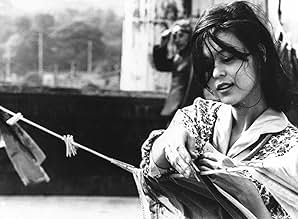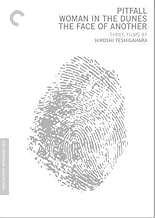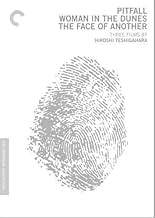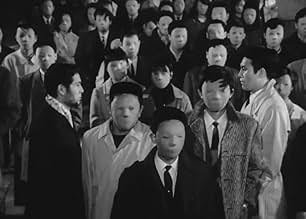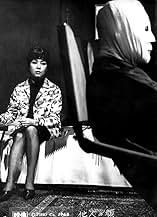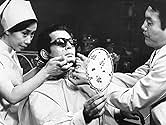Homem perde o rosto em um acidente e temendo o fim de seu casamento decide procurar um ousado cirurgião que acaba de inventar um método de transplante de rosto. O problema é encontrar alguém... Ler tudoHomem perde o rosto em um acidente e temendo o fim de seu casamento decide procurar um ousado cirurgião que acaba de inventar um método de transplante de rosto. O problema é encontrar alguém que doará sua face.Homem perde o rosto em um acidente e temendo o fim de seu casamento decide procurar um ousado cirurgião que acaba de inventar um método de transplante de rosto. O problema é encontrar alguém que doará sua face.
- Prêmios
- 2 vitórias no total
- Foreign man in Bar
- (não creditado)
Avaliações em destaque
The film combines several hoary and not particularly profound narrative contrivances. Here's a man attempting to seduce his wife, pretending to be another person--this was old when THE GUARDSMAN first went on stage and has been done countless times. Then there's the classic mad scientist, presented with very little nuance, delving into Things that Man Was Not Meant to Know. Related to this is that the story is only able to exist by grossly underestimating man's ability to adapt to the unknown. (An example is the 1952 science fiction story "Mother" by Alfred Coppel in which astronauts all return insane when confronted with the vastness of space.) These primitive tropes are shamelessly built on a simple narrative situation that is completely unable to carry them: a man with a disfigured face getting facial reconstruction. This happens all the time, so what's to "not meant to know"? If all this isn't enough, Teshigahara tacks on an unrelated, completely separate set of characters in their own undeveloped narrative that even Quandt thinks doesn't work. The dialogue by author/screenwriter Kobo Abe is risible, sounding like something out of a grade-B forties horror film.
To disguise the paucity of the film's narrative, Teshigahara has tricked it up with what Quandt admiringly calls "its arsenal of visual innovation: freeze-frames, defamiliarizing close-ups, wild zooms, wash-away wipes, X-rayed imagery, stuttered editing, surrealist tropes, swish pans, jump cuts, rear projection, montaged stills, edge framing, and canted, fragmented, and otherwise stylized compositions." These arty-farty gimmicks (and more) are, of course, hardly "innovations." They were endemic in the early sixties. Their extensive use seems a vain attempt to disguise the film's shallow content. Quandt also sees great significance in the many repetitions in the film: I see only repetition.
But even that is not the film's worst problem. Teshigahara often seems like a still photographer lost in a form that requires narrative structure. His inability to develop a sustained narrative makes the film seem far longer than its already-long two hours plus. Things happen, but the film doesn't really progress. The end result is little more than a compendium of tricks and narrative scraps borrowed from others.
The Face of Another is a fascinating film that highlights the social attitudes to physical appearance. There are hundreds of films and morality tales that teach you that it is inner beauty that counts, and once you allow this to shine then your physical attractiveness becomes irrelevant. Everyone knows that this is bullshit, so its refreshing to see a film that makes it clear from the outset that physical appearance has a massive part to play in society. Okuyama's new face, which is an attractive one, changes him so much that he takes on an almost dual identity. Dr. Hira delights in telling him that he has bought flashy new clothes, something he was never concerned with before. It becomes clear that whilst before Okuyama merely wanted to be normal again and fit back in society, his new face is engulfing him, and to be 'normal' simply isn't enough anymore.
As with many of the Japanese New Wave film-makers of the 1960's-70's, director Hiroshi Teshigahara takes some bold steps and sneaks in some surrealist and art-house values in a movie that is otherwise played relatively straight. A 'fictional' character appears every now and then throughout (she is first imagined by Okuyama's wife as a character in a movie); one side of her face is scarred and burned. She appears quite rarely, but seems to serve as an alternative to Okuyama's increasingly vain soul. Another scene seems a ball of hair that floats in the air, unnoticed by the people in the laboratory. I have no idea what it meant, and couldn't really admit to it being wholly successful, but it certainly got my attention nonetheless.
A powerful, disturbing, and poignant drama/horror from the greatest era in Japanese cinema. The film seems all the more important now, 45 years on, in a world where a botox injection can be as easy as buying a pack of cigarettes, and where physical 'beauty' is less a bonus than a necessity.
www.the-wrath-of-blog.blogspot.com
This is so excellent in every way. It is not a sci-fi movie, but in feel it sometimes comes close to. The images are quite surreal at times, the music is out of this world and some of the sets are not to be found in real life.
The editing is masterfully done, switching between main story and a parallel story about a girl with a similar problem, as well as switching between hand-held camera (not too shaky though), still pictures and still standing camera. The pictures of Segawa Hiroshi fits 35mm nicely, sometimes manipulating the background like I haven't seen before for example when the psychiatrist and Mr. Okayama is talking at the club and the crowd behind get 'invisible' by lighting.
Kyou Machiko did a terrific job in Ozu's 'Ukigusa' and likewise here. Too bad we don't see that much of her. Nakudai Tatsuya plays well as the mask. I don't know exactly what was special effects and not, but it was hard to tell.
Author and writer of screenplay Abe Koubou, director Teshigahara Hiroshi and Takemitsu Touru was behind another favourite of mine; 'Suna no Onna'. They also made 'Moetsukita Chizu' and I cant wait to get my hands on it!!
Você sabia?
- CuriosidadesDirector Hiroshi Teshigahara said that he intended the film to explore both personal and cultural identities. While the examination of personal identity is quite overt, Teshigahara also explored how Japan's cultural identity had been impacted by World War II and its aftermath.
- Citações
Psychiatrist: You're not the only lonely man. Being free always involves being lonely. Just there is a mask you can peel off and another you can not.
- ConexõesReferenced in O Funeral das Rosas (1969)
Principais escolhas
- How long is The Face of Another?Fornecido pela Alexa
Detalhes
Bilheteria
- Faturamento bruto mundial
- US$ 35.185
- Tempo de duração2 horas 2 minutos
- Cor
- Mixagem de som
- Proporção
- 1.33 : 1



